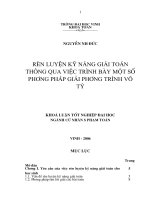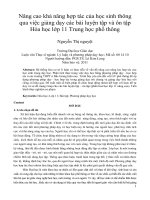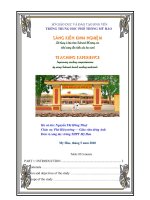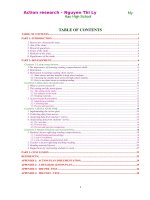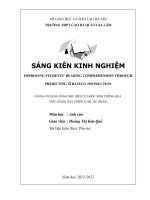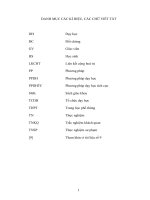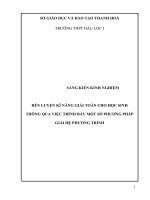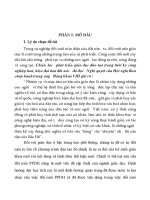skkn nâng cao khả năng đọc hiểu của học sinh thông qua việc giảng dạy chiến lược dự đoán
Bạn đang xem bản rút gọn của tài liệu. Xem và tải ngay bản đầy đủ của tài liệu tại đây (1.01 MB, 22 trang )
1
SỞ GIÁO DỤC VÀ ĐÀO TẠO HÀ NỘI
TRƯỜNG THPT CAO BÁ QUÁT GIA LÂM
SÁNG KIẾN KINH NGHIỆM
IMPROVING STUDENTS’ READING COMPREHENSION THROUGH
PREDICTING STRATEGY INSTRUCTION
(NÂNG CAO KHẢ NĂNG ĐỌC HIỂU CỦA HỌC SINH THÔNG QUA
VIỆC GIẢNG DẠY CHIẾN LƯỢC DỰ ĐOÁN)
Môn học : Anh văn
Giáo viên : Hoàng Thị Kim Quế
Tài liệu kèm theo: Phụ lục
Năm học 2011-2012
PART I. INTRODUCTION
1. Rationale
Reading is an essential skill for English as a foreign language (EFL)
students; and for many, reading is the most important skill to master. With
strengthened reading skills, EFL readers will make greater progress and attain
greater development not only in English but also in all academic areas. Therefore,
“reading is the most heavily researched single area of the whole curriculum, and
yet, paradoxically, it remains a field in which a good deal of fundamental work
has yet to be approached, and one in which a great many teachers would claim to
be almost wholly ignorant” and secondary teachers “who have generally had no
training at all related to reading but nevertheless feel conscious that the ability to
read fluently is the basis for most school learning, and one of the surest predictors
of academic attainment” (Harrison and Gardner, 1977).
Traditionally, attempts to improve the comprehension of texts for EFL
students have focused on familiarizing the students with vocabulary needed to
comprehend the passage. However, within the last 15 years, much of the research
conducted in the field of reading comprehension has concentrated on the
knowledge and control of reading strategies, and more and more emphasis has
been put on the importance of training EFL learners to be strategic readers.
Studies have revealed that the use of appropriate reading strategies may improve
reading comprehension (Olsen and Gee, 1991), and using reading strategies can be
of great help to non-native readers because they may serve as effective ways of
overcoming language deficiency and obtaining better reading achievement on
language proficiency tests (Wong, 2005; Zhang, 1992).
However, empirical research indicates that in most reading classrooms,
students have received inadequate instruction on reading skills and strategies
(Miller and Perkins, 1989). EFL teachers seldom teach a strategy explicitly in
class. In other words, teachers normally stress on the production of reading
comprehension rather than the reading process. Reading lessons are more of
reading tests, in which teachers ask the students to read the text and complete
several reading tasks. This problem can be found in many EFL reading classes in
the world, and Vietnam is not an exception. Vietnamese learners of English, in
general, and students at Cao Ba Quat Upper Secondary School in particular, after
several years of learning English, turn out to be word-by-word readers; they tend
to read very slowly to understand the meaning of every single word. When they
encounter unfamiliar words or unfamiliar concepts, they feel discouraged and
resort to wild guessing to construct the text meaning. Some students do not
understand the main idea of a text even when they have translated every word into
their mother tongue. Very few students deliberately look at the title of a text to
think about its topic before reading. Fewer students use their background
knowledge to facilitate their comprehension. They are completely dependent on
2
the decoded messages from the text, so once their decoding mechanisms fail due
to their deficient language proficiency, comprehension breaks down.
With a view to gaining some insight into reading strategies and reading
strategy instruction, I chose to study how to improve students’ reading
comprehension through predicting strategy instruction. The rationale for my focus
on predicting strategies is that they are of key importance in the comprehension
process. It has been found out that efficient reading often includes the use of
predicting strategies (Goodman, 1976; Palincsar & Brown, 1984). Interacting with
text, readers use their prior knowledge in concert with cues in the text to generate
predictions.
2. Aims.
My study aims at, firstly, examining the impact of the predicting strategy
instruction on the reading comprehension of 10th grade students at Cao Ba Quat
Upper Secondary School, and secondly, determining effective techniques to teach
predicting strategies in reading comprehension in their reading classes, from the
teacher’ and students’ perspectives.
3. Scope of the Study
This study only focuses on the teaching of predicting strategies to 10
th
grade
students at Cao Ba Quat Upper Secondary School, so the teaching of other reading
strategies or to other subjects would be beyond the scope.
3
PART II. DEVELOPMENT
1. Literature Review
Reading is “a fluent process of readers combining information from a text
and their own background knowledge to build meaning. The goal of reading is
comprehension…The text, the reader, fluency, and strategies combined together
define the act of reading” Anderson (2003, p. 68)
There are three Reading models: bottom-up, top-down and interactive.
Bottom-up Reading Model
All the proponents of bottom-up models agree that comprehension begins
by processing the smallest linguistic unit and working toward larger units, and
proceeds from part to whole. In this way, bottom-up theorists view reading as a
passive process dependent on the written or printed text.
Top-down Reading Model
This model, beginning in mind of the readers with meaning-driven
processes, or an assumption about the meaning of a text, emphasizes what the
reader brings to the text; reading is driven by meaning, and proceeds from whole
to part. From this perspective, readers identify letters and words only to confirm
their assumptions about the meaning of the text.
Interactive Reading Model
An interactive reading model attempts to combine the valid insights of
bottom-up and top-down models. It attempts to take into account the strong points
of the bottom-up and top-down models, and tries to avoid the criticisms leveled
against each, making it one of the most promising approaches to the theory of
reading today. As in top-down models, the reader uses his or her expectations and
previous understanding to guess about text content and, as in bottom-up models,
the reader decodes what is in the text. Text sampling and higher- level decoding
and recoding operate simultaneously.
Reading Strategies
Strategies are “actions or series of actions employed in order to construct
meaning. Reading strategies can also be understood as “the special thoughts or
behaviors that individual use” to help them to comprehend, learn and retain new
information from the reading text. More specifically, reading strategies are special
Bottom
Up
Down
Top
Interactive
4
actions students take on paper, in their heads, or aloud that help them understand
what they are reading. Therefore, they are both observable and unobservable.
Researches reveal that effective readers spontaneously use reading
strategies in the reading process, and the use of appropriate reading strategies may
improve reading comprehension. Using reading strategies can be of great help to
non-native readers because it may serve as an effective way of overcoming
language deficiency and obtaining better reading achievement both for regular
school assignments and on language proficiency tests.
Predicting Strategies is a family of strategies. Here is the list of the
activities to develop predicting strategies.
• Pre-reading activities: activating prior knowledge, previewing and
overviewing,
• While-reading activities: reading to confirm the prior predictions and
predicting what to come next.
BEFORE READING
Activating background
knowledge
• Open prediction
• True/ False prediction
• Pre-question
• Network
• If You Don’t Know, Ask, OK?
Previewing
• Look at the title and the headings for each
section to predict what the reading text is
about.
• Look at the pictures to predict what the
reading text is about.
Overviewing
• Read the first and the last paragraphs each
paragraph to predict what it is about.
WHILE READING
Reading and Confirming
Prior Predictions
• Read and confirm or reject the prior
predictions
Predicting What to Come
Next
• Use the prior knowledge about the topic to
predict what to come next in the passage
• Use the prior knowledge about the textual
structure of the text to predict what to
come next.
5
2. Research Methodology
This study was implemented in the second semester of the school year 2010 -
2011 with the participation of 50 students from Group 10A10 at Cao Ba Quat
Upper Secondary School.
In order to achieve the aims of the study, I carried out a predicting strategy
instruction course on my students. During this course, the students received two
forty-five-minute lessons and one ninety-minute lesson in which predicting
strategies were taught explicitly in combination with such reading strategies as
skimming and scanning. These lessons were developed by the researcher for the
sake of the study. Each lesson of strategy instruction included an explicit
description of the strategy and when and how it should be used, teacher and/or
student modeling, guided practice with gradual release of responsibility and
independent use. During the process of designing the lesson plan, I took into
consideration of not only the strategy instruction but also such components as
background knowledge, reading group organization, reading materials and
activities, and feedbacks.
Lessons Objectives
1
To develop the strategies of predicting the topic from the title and
predicting the content from the picture.
2
To develop the strategies of predicting the main idea of a paragraph
from the first sentence.
3
To develop strategies of using prior backgrounds knowledge of the
content and the knowledge of the textual structure to predict what to
come next in the text.
Syllabus of Predicting Strategy Instruction Course
To investigate the students’ improvement in their English reading
comprehension, I developed two reading tests, one of which was conducted at the
beginning of the research as the pre-test and after the intervention as a delayed
post-test and the other after the intervention as an immediate post-test. These tests
were adapted from the reading tests in the course book Interaction Access.
Obviously, necessary changes were made to fit the purpose of the study, and to
guarantee their equal value in terms of vocabulary, content and difficulty level.
These tests were designed as achievement tests, which normally “aim to find out
how much each student, and the class as a whole, has learnt of what has been
taught, to provide feedback on students’ progress to both teacher and students, to
show how effectively the teacher has taught”.
Each test consists of two reading passages, which are followed by five
multiple-choice reading questions. The participants were required to read the
passages to choose the best answer for each question. The time allowance for each
test was fifteen minutes. To ensure that the tests can give a reliable answer to the
6
first research question, the researcher bore in mind such qualities of a good test as
validity, reliability, discrimination, practicality, and washback.
Data were also collected by means of the researcher’s diary and the students’
journals during the implementation of the project. As can be inferred from
Kemmis’ cycle, reflection is one of the major steps. Teacher’s diary and students’
journals provide some reflection on the part of the teacher as the researcher and
the students as the participants respectively.
3. Results and Discussion
After the implementation of the predicting strategies on the participants, it
was found out that:
Firstly, the predicting strategy instruction has made some improvement in
the students’ reading comprehension. This can be demonstrated through the
following table and graph:
Pre-test Immediate Post-test Delayed Post-test
50% 72% 64%
Percentage of the Students’ Correct Answers in the Pre-test and Post-tests
Percentage of the Students’ Correct Answers to Each Question in the Pre-test and Post-
tests
1) Predicting from the title
2) Predicting from the picture
3) Predicting from the first sentence of a paragraph
4) Predicting from the prior knowledge of the topic
5) Predicting from the prior knowledge of the textual structure
As can be seen, the students were significantly better at finding the topic of
the text, answering the detailed questions with the help from the picture, and
anticipating the upcoming information from the textual structure. Although the
predicting strategy instruction has raised the students’ awareness of these reading
strategies considerably, and enabled them to make use of these strategies in their
reading, the difference is not significant because reading comprehension is
influenced by not only strategies but also other factors such as the text and the
reader’s vocabulary as well as background knowledge. Furthermore, predicting
7
strategies are only a fraction of language learning strategies. The relationship
among different factors of reading can be demonstrated through the following
figure:
Secondly, throughout my research, I have found out some effective
techniques to teach the students predicting strategies.
• The most effective one, as perceived by the teacher and the students, is that
the predicting strategy course should include Explicit strategy instruction,
consisting of an explicit description of the strategy including when and how to
use it, teacher’s modeling, student’s modeling accompanied by the teacher’s
explanation of each step, guided practice with gradual release of responsibility,
and independent use.
• The second most effective technique, as perceived by the teacher and the
students, is that in order to teach the students predicting strategies effectively,
the teacher should conduct exciting, real-life, practical and useful tasks that
equip the students with sufficient vocabulary and knowledge related to the
text, and help them practice the strategies effectively. The learning principle
underlying the task-based approach proposes students will learn best if they
engage in tasks that require them to use language in ways that closely resemble
how language is used naturally outside the classroom (Bachman, 1990).
Besides that, exciting, practical and useful task ensure that students want to
learn, have the desire to accomplish the task, have a positive attitude toward
the task, and exhibit effort to accomplish the task, which build motivated
readers.
8
• Next, the teacher and the students perceived Interesting and
comprehensible reading texts of familiar topics would guarantee the
effectiveness of the predicting strategy instruction. Interesting texts motivated
the students by making them want to read, whereas familiar topics and
comprehensible inputs motivated them by making them believe in their ability
including the ability to make predictions about the text and comprehend it.
Reading motivation facilitates the strategy use.
• Pair work and group work are also very useful to the strategy learning. In
fact, cooperation in such small groups provide students with more
opportunities to share their own thoughts among the members, which really
facilitates the strategy use because in such groups students of various abilities
and skills are supposed to provide scaffolding support for each other’s reading
processes. Moreover, with predicting strategies, cooperative learning enables
students to broaden their knowledge and vocabulary related to the topic, and
students, therefore, also have more opportunities to verify their predictions,
clarify their confusion in terms of the text meaning and the strategy use, and
advance their reading ability.
• Furthermore, giving feedbacks was also reported to be of great use to the
students in their practice of predicting strategies. Feedbacks on the reading
process enabled the students to reflect on their thinking during reading, finding
out what they had achieved and what needed improving.
• Finally, clear instructions and detailed modeling, especially of Planning and
Report stages of Task cycle, ensure better performance of the tasks, which
contributes to successful strategy learning.
9
PART III. CONCLUSIONS
1. Pedagogical Implications
This study has shed some light on the impact of predicting strategies on Cao
Ba Quat Upper Secondary School’ 10th grade students’ reading comprehension
and effective techniques to teach predicting strategies to these subjects. From the
findings of the study, I come up with some pedagogical implications for upper
secondary school reading instruction in EFL contexts.
Firstly, it is advisable to teach the students predicting strategies as well as
other reading strategies such as skimming, scanning, guessing word meaning in
context.
Secondly, it is important for teachers to recognize that learners’ effective
use of a reading strategy like predicting requires teachers’ thoughtful planning to
help them identify the nature of reading process and raise their awareness of the
necessity for the shift in their reading behaviours. Therefore, teacher should: 1)
assess students’ awareness of strategy use; 2) raise their awareness of the
importance of strategic reading; 3) raise their awareness of the array of strategies
available to aid reading comprehension; and then 4) provide explicit strategy
instruction. Teachers should also understand that developing students’ strategic
reading is not simply a matter of introducing them to a number of reading
strategies, but promoting mastery of these strategies involves teachers’ constant
modeling and instant feedback not only at the beginning but also through the
whole implementation of the strategy instruction.
Finally, it is suggested that strategic reading should be entwined with
enhanced content and formal schemata, especially content schemata. As seen in
the study, students could not made good use of predicting strategies in their
reading comprehension because of their deficiency in their prior knowledge of the
text topic and the textual structure as well as their vocabulary. Nevertheless, in
many cases, even though the students understood all the linguistic cues, they
failed to make predictions due to their insufficient relevant prior knowledge of the
topic. Therefore, it is vital that teachers help students broaden their knowledge and
vocabulary, and this might be aided by extensive reading. Teachers should
frequently assign students reading texts of different topics and structures, then ask
them to summarize each text in the form of network, or semantic map and note
useful words and phrases. By this means, students’ world, vocabulary and
structural knowledge stores are also expanded, which enhances linguistic
proficiency. In addition, during each strategy instruction lesson, the teacher should
use a number of techniques for the activation of the students’ prior knowledge and
review of textual structures and useful vocabulary so that they can make full use
of their prior knowledge to facilitate their reading comprehension.
10
APPENDIXES
Appendix 1: Pre-test and Delayed post-test
READING COMPREHENSION TEST
Read the following passages and choose the best answer for each question.
Passage 1: Niagara Falls
A. Niagara Falls, one of the most famous North American natural wonders, has long
been a popular tourist destination. Tourists today flock to see the two falls that actually
constitute Niagara Falls: the 173 –foot Horseshoe Falls on the Canadian side of the Niagara
River in the Canadian province of Ontario and the 182- foot high American Falls on the U.S
side of the river in the state of New York. Approximately 85 percent of the water that goes over
the falls actually goes over Horseshoes Falls, with the rest going over American Falls.
B. Most visitors come between April and October, and it is quite a popular activity to
take a steamer out onto the river and right up to the base of the falls for a close- up view. It is
also possible to get a spectacular view of the falls from the strategic locations along the Niagara
River, such as Prospect Point or Table Rock, or from one of the four observation towers which
have heights up to 500 feet.
C. Tourists have been visiting Niagara Falls in large numbers since the 1800s; annual
visitation now averages above 10 million visitors per year. Because of concern that all these
tourists would inadvertently destroy the natural beauty of this scenic wonder, the state of New
York is 1885 created Niagara Falls Park in order to protect the land surrounding American Falls.
A year later Canada created Queen Victoria Park on the Canadian side of the Niagara, around
11
American Falls
Horseshoe
Falls
CANADA
RIVER NIAGARA
Horseshoe Falls. With the area surrounding the falls under the control of government agencies,
appropriate steps could be taken to preserve the pristine beauty of the area.
1. According to the passage, what which of the following best describes Niagara Falls?
A. Niagara Falls consists of two rivers, one Canadian and the other American.
B. American Falls is considerably higher than Horseshoe Falls.
C. The Niagara Rivers has two falls, one in Canada and one in the United Sates.
D. Although the Niagara River flows through the United States and Canada, the
falls are only in the U.S
2. According to the passage, why was Niagara Falls Park created?
A. To encourage tourists to visit Niagara Falls
B. To show off the natural beauty of Niagara Falls
C. To protect the area around Niagara Falls
D. To force Canada to open Queen Victoria Park
3. The paragraph following the passage most probably discusses
A. additional ways to observe the falls
B. steps taken by government agencies to protect the falls
C. a detailed description of the division of the falls between the United States and
Canada.
D. further problems that are destroying the area around the falls.
Passage 2: Listening Online
A. Twenty years ago, most people listened to music on records or tapes. The sound
quality was not very good. Then, in the early 1980s, the compact disc (CD) appeared on the
market. The sound quality was better, and CDs were easier to take care of. Nobody thought
records were going to disappear, but now records are not manufactured (made), and very few
people buy them. The next question is: Will the CD ever disappear? How will we be listening to
music twenty years from now? Some people think the CD will disappear as well. Already,
12
people are listening to MP3 files (digital music files) and downloading music from the Internet.
Downloading is when you move files from the Internet to your own computer.
B. Napster was the first company to use the Internet to help people share music. A
college student named Shawn Fanning started the company in 1998. Shawn discovered a way to
allow people to download songs from each other's computers. Over 70 million people used
Napster. The record companies were very angry. They thought that people were using Napster
to steal music. The record companies took Napster to court. In 2000, a judge ordered Napster to
close. Will that be the end of free online music sharing? Probably not.
C. Napster is starting a new Web site together with a record company. On this new site,
people will pay money to share music. But most of the 70 million people who used Napster
want their music for free. They are finding many other file-sharing sites that help them share
MP3 files, such as Audiogalaxy, BearShare, and Aimster. These Web sites are not actual
companies, so the record companies cannot take them to court.
D. Are people going to stop buying CDs and get all their music online? Or are the record
companies going to stop music sharing forever? No one knows for sure. CDs are convenient and
easy to use. Many people still don't have computers, and downloading music can be very slow.
One user sums it up: "I download music all the time—about 100 to 150 songs a day. I have over
4,000 songs on my computer. But I'll never stop buying CDs because it's important for people to
support the musicians they like." For now, the CD is alive and well, but for how long?
4. Which phrase below best tells the topic of the passage?
A. The future of music. B. The return of record.
C. The disappearance of CDs. D. The benefit of Internet.
5. The main idea of Paragraph D is __.
A. File sharing will become more popular than CDs.
B. CDs and file sharing may or may not be around for a long time.
C. The record companies will probably stop file sharing.
D. CDs will become popular again.
13
Appendix 2: Immediate Post-test
READING COMPREHENSION TEST
Read the following passages and choose the best answer for each question.
Passage 1
Rain Forests and the Earth’s Climate
The Importance of Rain Forests
Rain forests cover only about six percent of the earth's surface, but they are very
important to the earth. What is a rain forest? It is an area of land that gets a lot of rainfall and is
mostly covered by tall, old trees. Some rain forests get up to 33 feet (10 meters) of rain each
year. Some of their trees are thousands of years old. Most of the world's rain forests are in
Africa, Asia, Australia, Central America, and South America. More than half of the world's
plant and animal species live in rain forests or originally came from rain forests. Scientists
continue to discover plants in the rain forests that have medicinal value (useful for treating
medical problems). In fact, over 25 percent of the medicines we have come from rain forest
plants. And there are still a lot of plants to find.
The Effects of Rain Forests on the Earth's Climate
But rain forests are important not only for the plants and animals that live in them and
for the medicines that come from them. They also have major effects on the earth's atmosphere
and climate. According to some scientists, global warming is causing dangerous changes to the
earth's climate. Rain forests can help us fight global warming. Some scientists believe that rain
forests cool the atmosphere by absorbing the sun's heat. Absorb means to soak up. Also, plants
and trees use carbon dioxide. The cause of global warming is an increase of gases like carbon
dioxide in our atmosphere. So rain forests can clean some of the excess (extra) carbon dioxide
out of the air.
14
A
B.
How We Are Destroying Rain Forests
Rain forests are so important to the earth, but we are cutting them down and burning
them very quickly. Why? Some companies want to use the trees to make wood and paper.
Others want to use the land to raise animals or grow crops (plants that farmers grow to use as
food). This is dangerous for the climate in two ways. First, we are destroying something that
helps cool down the earth's atmosphere. And second, by burning rain forests, we add a lot of
carbon dioxide to the air. In fact, the burning of rain forests is responsible for about 30 percent
of the carbon dioxide in our atmosphere. Some people believe that in 40 years, all the rain
forests will be destroyed. What will happen to the earth's climate when all the rain forests are
gone?
1. What is the main idea of this passage?
A. Rain forests are important because they are very old and most of our medicines come
from their plants.
B. We need to protect rain forests because they are important to the earth in many ways.
C. We are destroying the rain forests very quickly.
D. The rain forests are important, but they do not have major effects on the earth’s climate.
2. Rain forests can be helpful to the earth because _____
A. they heat the atmosphere. B. they put carbon dioxide into the atmosphere.
C. they burn carbon dioxide in the atmosphere.
D. they absorb the carbon dioxide in the atmosphere.
3. Burning rain forests _____
A. helps farmers grow strong crop. B. adds carbon dioxide to the air.
C. cools the atmosphere. D. cools the carbon dioxide in the air.
Passage 2 Internet Shopping
Twenty-five years ago, very few people used the
Internet. Only scientists and people in the government
knew about the Internet and how to use it. This is
changing very fast. Now almost everyone knows
about the Internet, and many people are online
everyday. When people think about the Internet, they
often think about the information. But now, more and
more, when people think about the Internet, they think
about shopping.
15
C
A.
.
Amazon.com was one of the first companies to try to sell products on the Internet. Jeff
Bezos started the company. One day he made a prediction about the future. He saw that the
World Wide Web was growing 2,000 percent a year. He predicted that it was going to continue
to grow, and he thought that shopping was going to move to the Internet. People were going to
shop online. He quit his good job and drove across the country to Seattle, Washington. There he
started an online bookstore called Amazon.com. Bezos had very little money. The company
began in a garage, and at first there were very few customers.
At the Amazon.com site, people can search for a book about a subject, find many different
books about that subject, read what other people think about the book, order them by credit
card, and get them in the mail in two days. This kind of bookstore was a new idea, but the
business grew. In a few years, Amazon.com had 10 million customers and sold 18 million
different items in categories including books, CDs, toys, electronics, videos, DVDs, home
improvement products, software, and video games. Today, at a “virtual shopping mall” – a
group of online stores - you can buy anything from gourmet food – special, usually expensive
food – to vacations.
Fifteen years ago, many people said, “Online
shopping is crazy. Nobody can make money in an online
company.” They were wrong. Today, Jeff Bezos is a
billionaire. More and more people are shopping on line,
and online companies are making a profit. It is a huge
business.
Jeff Bezos giving a speech
4. The main idea of paragraph B is _________
A. the Web was growing 2,000 percent a year.
B. Amazon.com is a famous online bookstore.
C. Jeff Beros quit his good job and moved to Seattle, Washington.
D. Amazon.com is an example of a company that sells on the Internet.
5. The following part of paragraph D most probably discusses _____
A. Jeff Beros. B. online shopping in the future.
C. how scientists use the Internet. D. other uses of the Internet.
16
B.
.
C.
.
D.
.
B.
.
Appendix 3: Lesson Plan for the Lesson on Predicting the Topic from the Title and Predicting some Content from the Picture(s)
I. Level: 50 students - Pre-intermediate level of English
II. Time Allowance: 45’
III. Aims: At the end of the lesson, …
• The students can predict the content of a text by using the title (subtitle or headings, if present) and other visually prominent
text information (pictures, photographs, graphs, charts, table, ).
IV. Assumed Knowledge: Students have some idea of what to think of when making a decision on a tour, and some words and
phrases related to the topic: “Vacation”
V. Anticipated Problems: - Students may not be familiar with how to conduct a task, and how to report a task.
- Students may not be familiar with how to make predictions and how to read to confirm the predictions
and draw conclusion.
- Students may not know some words and phrases in the text, how to guess these words in contexts, and
which words should be skipped during the reading.
VI. Teaching Aids: Advertisements for some tours, handouts.
VII. Procedures:
Stage Time Aims Teacher’s Activities Students’ Activities
1.Warm-up 7’ To motivate the
students to learn the
lesson and to introduce
the predicting strategy.
Task 1: Making decisions on the tour to go on
during the summer vacation.
- Elicit what to think of when making a decision on
a tour.
- Divide the class into groups of four.
- Give each group a set of four different tour
advertisements with only the titles and the
illustration photographs.
- Tell the students to imagine that they are looking
for a tour to go on during the summer vacation,
and that they are going to study these incomplete
advertisements, and make a decision on which tour
they would like to have based on the content of the
- Talk about what to think of
when making a decision on a
tour.
- Make up the groups.
- Listen to the teacher’
instruction.
ad predicted through the titles and the pictures.
- Giving the model. For example, I think we should
go to Ha Long because….
- Ask the students to prepare for the task
individually first.
- Ask the students work in groups, share with the
other group members which tour to choose, and
how to choose the tour among those advertised.
- Ask the students to prepare to report to the class
how they did the task and which tour they have
decided to choose.
- Ask some groups to present their reports, and the
whole class discusses to make the final decision on
the tour.
- Give feedbacks on the students’ report.
- Observe the modeling.
- Work individually, study the
titles and the photographs and
make decision on the tour and
give the reason for the choice.
- Work in groups, talk to each
other about which tour to
choose, and how to choose the
tour among those advertised.
- Each group prepares the report.
- Present the report.
2. Lead -in 1’ To introduce the
lesson
- Tell the students that they are going to learn how
to predict the topic of a text from the title (subtitle
or heading, if present) and other visually
prominent text information (pictures, photographs,
graphs, charts, table, )
- Listen
3. Before
You Read
7’ To activate the
students’ background
knowledge about the
topic and review useful
words and phrases.
Task 1: Conducting a survey of the things people
like to do on vacation.
- Ask the students to look at the pictures, and work
in pairs to answer the following questions:
Where are these people on vacation?
What are they doing?
Which of these activities do you enjoy?
- Look at the pictures, read the
questions given and work in
pairs to answer these questions.
- Read the list of the activities
that people like to do on
5’ To practice predicting
what the text is about
through the title, pictures
and headings.
- Ask the students to read the list of the activities
that people like to do on vacation, then check all of
the things that they like to do on vacation and add
two more things.
- Ask the students to share their lists with other
partners.
- Ask the students to report the result of their survey
in front of the class.
- Lead the students to identify the topic of the
reading lesson.
- Review useful words and phrases and present
some others that may be found in the reading text.
Task 2: Previewing the Reading.
- Ask the students to look at the title of the reading
text, and the pictures and headings in the text to
predict the topic of the text that they are going to
read.
- Model the prediction.
Based on the title of the text, the photos and the
headings in the text, I predict that the text is about
_____.
- Do the task individually, predicting what the text is
about.
- Ask the students to share their predictions with
vacation, then check all of the
things that they like to do on
vacation and add two more
things.
- Share the list with other
partners.
- Report the result of the survey
in front of the class.
- Predict the topic of the lesson.
- Review useful words and
phrases related to the topic.
- Listen to the instruction.
- Observe the modeling.
- Work individually, studying the
title of the reading text, the
pictures and heading in the
reading text to predict what the
text is about.
- Share the predictions with
their partner.
- Ask the students to report the topics predicted and
write these topics on the board.
partner.
- Report the anticipated topics
and copy the ones that the
students think might be the
most likely topic of the text.
4. While
You Read
10’
10’
To practice reading for
the main idea of the text,
using predicting strategy.
To practice reading for
specific information,
using predicting strategy.
Task 1: Finding the Main Idea
- Ask the students to read the text quickly to choose
the main idea of the text.
- Model the task.
I read the text quickly from beginning to end. While
reading, I check which prior predictions are correct
or formulate other predictions about the main idea of
the text. Finally, I choose the main idea among the
sentences given.
- Ask the students to share their answers with their
partners, discussing how they found the main idea
and what their best choice of the main idea is.
- Ask the students to report their answer.
- Give feedbacks on the students’ report.
- Give the correct answer.
- Ask the students to identify the process of finding
the main idea of a text.
Task 2: Deciding which tour is best for each
person.
- Ask the students to read what different people say
about their traveling.
- Listen to the instruction.
- Observe the modeling
- Work in pairs, discussing how
the main idea was found and
which given sentence is the
main idea.
- Report the answers in front of
the class.
- Check the answer.
- Try to identify the process of
finding the main idea of the
reading text.
- Read what different people say
about their traveling.
- Ask the students to read the text to find out which
of the tours mentioned in the text is best for each
person.
- Model the task:
First, I read the heading of each paragraph and look
over the picture next to it. Then, I make predictions
on what the tour mentioned in the paragraph is. After
that, I read the text to confirm, reject or adjust my
prediction to get the right answer. Finally, I consider
each person’s statement about his/her traveling to
decide whether the tour mentioned in the text is best
for him/ her.
- Ask the students to do the task individually as
instructed.
- Ask the students to work in groups of four and
discuss how they did the task and what they
decided.
- Ask some groups to report to the class what they
have done, and the whole class makes the final
decision.
- Give feedbacks on the students’ report.
- Listen to the instruction.
- Listen to the modeling.
- Work individually, read the
headings and look over the
pictures to predict what tour is
mentioned in each paragraph,
then read the text silently to
check the predictions and
choose the best tour for each
person based on the specific
information in each passage.
- Work in groups of four and
discuss how the task was done
and what the decision was.
- Report in front of the class.
- Ask the students to review the process of reading
for specific information in the text.
- Review the process of reading
for specific idea in the text.
5. After
You Read
5’ To practice writing the
title of a tour
advertisement.
Task: Writing the title of an advertisement for a
tour.
- Ask the students to work in pairs to write the title
of an advertisement for a tour.
- Model the task.
- Conduct the task.
- Ask some pair to show the title and ask the others
to predict which tour is advertised.
- Listen to the instruction.
- Observe the modeling.
- Do the task in pairs, discuss to
make the title of an
advertisement for a tour.
- Show the title and the whole
class predict which tour is
advertised.
XÁC NHẬN CỦA THỦ TRƯỞNG ĐƠN VỊ
Hà Nội, ngày 22 tháng 5 năm 2012
Tôi xin cam đoan đây là SKKN của mình viết, không sao
chép nội dung của người khác.

